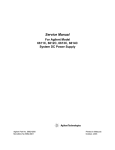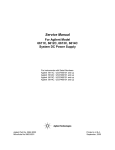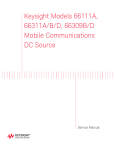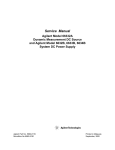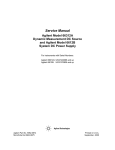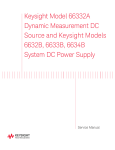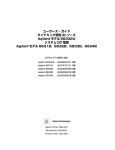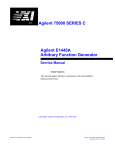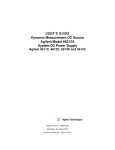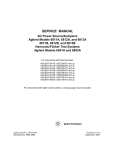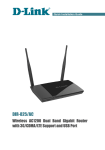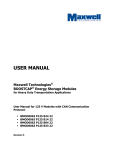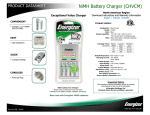Download 6631B Service Manual
Transcript
Service Manual Agilent Model 6631B System DC Power Supply s1 Agilent Part No. 5962-8202 Microfiche No 5962-8203 Printed in Malaysia April, 2003 Warranty Information CERTIFICATION Agilent Technologies certifies that this product met its published specifications at time of shipment from the factory. Agilent Technologies further certifies that its calibration measurements are traceable to the United States National Bureau of Standards, to the extent allowed by the Bureau's calibration facility, and to the calibration facilities of other International Standards Organization members. WARRANTY This Agilent Technologies hardware product is warranted against defects in material and workmanship for a period of one year from date of delivery. Agilent Technologies software and firmware products, which are designated by Agilent Technologies for use with a hardware product and when properly installed on that hardware product, are warranted not to fail to execute their programming instructions due to defects in material and workmanship for a period of 90 days from date of delivery. During the warranty period Agilent Technologies will, at its option, either repair or replace products which prove to be defective. Agilent Technologies does not warrant that the operation for the software firmware, or hardware shall be uninterrupted or error free. For warranty service, with the exception of warranty options, this product must be returned to a service facility designated by Agilent Technologies. Customer shall prepay shipping charges by (and shall pay all duty and taxes) for products returned to Agilent Technologies. for warranty service. Except for products returned to Customer from another country, Agilent Technologies shall pay for return of products to Customer. Warranty services outside the country of initial purchase are included in Agilent Technologies’ product price, only if Customer pays Agilent Technologies international prices (defined as destination local currency price, or U.S. or Geneva Export price). If Agilent Technologies is unable, within a reasonable time to repair or replace any product to condition as warranted, the Customer shall be entitled to a refund of the purchase price upon return of the product to Agilent Technologies. LIMITATION OF WARRANTY The foregoing warranty shall not apply to defects resulting from improper or inadequate maintenance by the Customer, Customer-supplied software or interfacing, unauthorized modification or misuse, operation outside of the environmental specifications for the product, or improper site preparation and maintenance. NO OTHER WARRANTY IS EXPRESSED OR IMPLIED. AGILENT TECHNOLOGIES. SPECIFICALLY DISCLAIMS THE IMPLIED WARRANTIES OF MERCHANTABILITY AND FITNESS FOR A PARTICULAR PURPOSE. EXCLUSIVE REMEDIES THE REMEDIES PROVIDED HEREIN ARE THE CUSTOMER'S SOLE AND EXCLUSIVE REMEDIES. AGILENT TECHNOLOGIES SHALL NOT BE LIABLE FOR ANY DIRECT, INDIRECT, SPECIAL, INCIDENTAL, OR CONSEQUENTIAL DAMAGES, WHETHER BASED ON CONTRACT, TORT, OR ANY OTHER LEGAL THEORY. ASSISTANCE The above statements apply only to the standard product warranty. Warranty options, extended support contacts, product maintenance agreements and customer assistance agreements are also available. Contact your nearest Agilent Technologies Sales and Service office for further information on Agilent Technologies' full line of Support Programs. 2 Safety Summary The following general safety precautions must be observed during all phases of operation of this instrument. Failure to comply with these precautions or with specific warnings elsewhere in this manual violates safety standards of design, manufacture, and intended use of the instrument. Agilent Technologies assumes no liability for the customer's failure to comply with these requirements. WARNING Servicing instructions are for use by service-trained personnel. To avoid dangerous electrical shock, do not perform any servicing unless you are qualified to do so. Some procedures described in this manual are performed with power supplied to the instrument while its protective covers are removed. If contacted, the energy available at many points may result in personal injury. BEFORE APPLYING POWER. Verify that the product is set to match the available line voltage, the correct line fuse is installed, and all safety precautions (see following warnings) are taken. In addition, note the instrument's external markings described under "Safety Symbols" GROUND THE INSTRUMENT. Before switching on the instrument, the protective earth terminal of the instrument must be connected to the protective conductor of the (mains) power cord. The mains plug shall be inserted only in an outlet socket that is provided with a protective earth contact. This protective action must not be negated by the use of an extension cord (power cable) that is without a protective conductor (grounding). Any interruption of the protective (grounding) conductor or disconnection of the protective earth terminal will cause a potential shock hazard that could result in personal injury. FUSES Only fuses with the required rated current, voltage, and specified type (normal blow, time delay, etc.) should be used. Do not use repaired fuses or short-circuited fuseholders. To do so could cause a shock or fire hazard. KEEP AWAY FROM LIVE CIRCUITS. Operating personnel must not remove instrument covers. Component replacement and internal adjustments must be made by qualified service personnel. Do not replace components with power cable connected. Under certain conditions, dangerous voltages may exist even with the power cable removed. To avoid injuries, always disconnect power, discharge circuits and remove external voltage sources before touching components. DO NOT SERVICE OR ADJUST ALONE. Do not attempt internal service or adjustment unless another person, capable of rendering first aid and resuscitation, is present. Any adjustment, maintenance, and repair of this instrument while it is opened and under voltage should be avoided as much as possible. When this is unavoidable, such adjustment, maintenance, and repair should be carried out only by a skilled person who is aware of the hazard involved. DO NOT SUBSTITUTE PARTS OR MODIFY INSTRUMENT. Because of the danger of introducing additional hazards, do not install substitute parts or perform any unauthorized modification to the instrument. Return the instrument to an Agilent Technologies Sales and Service Office for service and repair to ensure that safety features are maintained. SAFETY SYMBOLS Refer to the table on the following page WARNING The WARNING sign denotes a hazard. It calls attention to a procedure, practice, or the like, which, if not correctly performed or adhered to, could result in personal injury. Do not proceed beyond a WARNING sign until the indicated conditions are fully understood and met. Caution The CAUTION sign denotes a hazard. It calls attention to an operating procedure, or the like, which, if not correctly performed or adhered to, could result in damage to or destruction of part or all of the product. Do not proceed beyond a CAUTION sign until the indicated conditions are fully understood and met. 3 Safety Symbol Definitions Symbol Description Direct current Alternating current Both direct and alternating current Three-phase alternating current Earth (ground) terminal Protective earth (ground) terminal Frame or chassis terminal Terminal is at earth potential (Used for measurement and control circuits designed to be operated with one terminal at earth potential.) Terminal for Neutral conductor on permanently installed equipment Terminal for Line conductor on permanently installed equipment On (supply) Off (supply) Standby (supply) Units with this symbol are not completely disconnected from ac mains when this switch is off. To completely disconnect the unit from ac mains, either disconnect the power cord or have a qualified electrician install an external switch. In position of a bi-stable push control Out position of a bi-stable push control Caution, risk of electric shock Caution, hot surface Caution (refer to accompanying documents) 4 Notice The information contained in this document is subject to change without notice. Agilent Technologies makes no warranty of any kind with regard to this material, including but not limited to, the implied warranties of merchantability, and fitness for a particular purpose. Agilent Technologies shall not be liable for errors contained herein or for incidental or consequential damages in connection with the furnishing, performance or use of this material. This document contains proprietary information which is protected by copyright. All rights are reserved. No part of this document may be photocopied, reproduced, or translated into another language without the prior written consent of Agilent Technologies. Copyright 1998, 2000 Agilent Technologies, Inc. Printing History The edition and current revision of this manual are indicated below. Reprints of this manual containing minor corrections and updates may have the same printing date. Revised editions are identified by a new printing date. A revised edition incorporates all new or corrected material since the previous printing date. Changes to the manual occurring between revisions are covered by change sheets shipped with the manual. In some cases, the manual change applies only to specific instruments. Instructions provided on the change sheet will indicate if a particular change applies only to certain instruments. Edition 1...............................................................June, 1998 Edition 2...............................................................September, 2000 Update 1...............................................................April, 2003 Instrument Identification Agilent Technologies power supplies are identified by a 10-digit serial number. The format is described as follows: first two letters indicate the country of manufacture. The next four digits are a code that identify either the date of manufacture or of a significant design change. The last four digits are a sequential number assigned to each instrument. Item US 3631 0101 Description The first two letters indicates the country of manufacture, where US = USA; MY = Malaysia; SG = Singapore. This is a code that identifies either the date of manufacture or the date of a significant design change. The last four digits are a unique number assigned to each power supply. 5 Table of Contents Warranty Information Safety Summary Notice Printing History Instrument Identification Table of Contents 2 2 5 5 5 6 1 - INTRODUCTION 9 Organization Safety Considerations Related Documents Revisions Manual Revisions Firmware Revisions Electrostatic Discharge 9 9 9 10 10 10 10 2 - VERIFICATION AND PERFORMANCE TESTS Introduction Test Equipment Required Measurement Techniques Test Setup Electronic Load Current-Monitoring Resistor Operation Verification Tests Performance Tests Programming Constant Voltage (CV) Tests CV Setup Voltage Programming and Readback Accuracy CV Load Effect CV Source Effect CV Noise (PARD) Transient Recovery Time Constant Current (CC) Tests CC Setup Current Programming and Readback Accuracy Current Sink (-CC) Operation Low Range Current Readback Accuracy CC Load and Line Regulation CC Load Effect CC Source Effect CC Noise (PARD) Performance Test Equipment Form Performance Test Record Forms 3 - TROUBLESHOOTING Introduction Test Equipment Required Overall Troubleshooting Flow Charts Figure 3-1 Sheet 1. Troubleshooting Flowchart Figure 3-1 Sheet 2. Troubleshooting Flowchart Figure 3-1 Sheet 3. Troubleshooting Flowchart 6 11 11 11 12 12 13 13 13 13 14 14 14 14 15 15 15 16 17 17 17 17 18 18 19 19 20 21 22 23 23 24 24 24 25 26 27 Figure 3-1 Sheet 4. Troubleshooting Flowchart Specific Troubleshooting Procedures Power-on Self-test Failures CV/CC Status Annunciators Troubleshooting Bias and Rail Voltages Transformer Input J207 Voltage Measurements Manual Fan Speed Control Disabling Protection Features Post-repair Calibration Inhibit Calibration Switch Calibration Password Initialization ROM Upgrade Identifying the Firmware Upgrade Procedure Disassembly Procedures List of Required Tools Cover, Removal and Replacement A2 Interface Board, Removal and Replacement Front Panel Assembly, Removal and Replacement S1 Line Switch, Removal and Replacement A3 Front Panel Board, Removal and Replacement A1 Main Control Board T1 Power Transformer, Removal and Replacement Line Voltage Wiring 4 - PRINCIPLES OF OPERATION Introduction I/O Interface Signals A3 Front Panel Circuits A2 Interface Circuits Primary Interface Secondary Interface A1 Main Board Circuits Rail and Bias Circuits Output Power and Control Circuits Control Circuits 5 - REPLACEABLE PARTS LIST 28 29 29 30 30 30 31 32 32 33 33 33 34 34 34 34 35 35 36 36 36 37 37 37 37 38 39 39 39 40 40 40 40 41 41 42 42 45 Introduction 45 6 - DIAGRAMS 49 Introduction 49 49 50 51 52 Figure 6-1. A1 Board Component and Test Point Locations Figure 6-2. A1 Board Block Diagram Figure 6-3. A2/A3 Boards Block Diagram Figure 6-4. Rail and Bias Circuits INDEX 53 7 1 Introduction Organization This manual contains information for troubleshooting and repairing to the component level the Agilent Model 6631B System DC Power Supply. Hereafter it will be referred to as the dc power supply. This manual is organized as follows: Chapter 1 Organization Chapter 2 Performance tests Chapter 3 Troubleshooting procedures Chapter 4 Principles of operation on a block-diagram level Chapter 5 Replaceable parts Chapter 6 Diagrams Safety Considerations WARNING: Hazardous voltages exist within the dc power supply chassis. This dc power supply; is a Safety Class I instrument, which means it has a protective earth terminal. This terminal must be connected to earth ground through a power source equipped with a 3-wire, ground receptacle. Refer to the "Safety Summary" page at the beginning of this manual for general safety information. Before operation or repair, check the dc power supply and review this manual for safety warnings and instructions. Safety warnings for specific procedures are located at appropriate places in the manual. Related Documents The following documents are shipped with your dc power supply: a a User’s Guide, containing installation, operating, and calibration information a a Programming Guide, containing detailed GPIB programming information. 9 1 – Introduction Revisions Manual Revisions If changes have been made to your power supply since the publication of this manual, a yellow Manual Change sheet may be supplied with the manual. It defines the differences between your power supply and the unit described in this manual. The yellow change sheet may also contain information for correcting errors in the manual. Note that because not all changes to the product require changes to the manual, there may be no update information required for your power supply. Firmware Revisions You can obtain the firmware revision number by either reading the integrated circuit label, or query the dc power supply using the GPIB *IDN?' query command (See Chapter 3, ROM Upgrade). Electrostatic Discharge CAUTION: The dc power supply has components that can be damaged by ESD (electrostatic discharge). Failure to observe standard antistatic practices can result in serious degradation of performance, even when an actual failure does not occur. When working on the dc power supply, observe all standard, antistatic work practices. These include, but are not limited to: — Working at a static-free station such as a table covered with static-dissipative laminate or with a conductive table mat (Agilent P/N 9300-0797, or equivalent). — Using a conductive wrist strap, such as Agilent P/N 9300-0969 or 9300-0970. — Grounding all metal equipment at the station to a single common ground. — Connecting low-impedance test equipment to static-sensitive components only when those components have power applied to them. — Removing power from the dc power supply before removing or installing printed circuit boards. 10 2 Verification and Performance Tests Introduction This document contains test procedures to verify that the dc power supply is operating normally and is within published specifications. There are three types of tests as follows: Built-in Self Tests These tests, run automatically when the power supply is turned on, check most of the digital circuits and the programming and readback DACs. Operation Verification These tests verify that the power supply is probably operating normally but do not check all of the specified operating parameters. Performance Tests These tests check that the supply meets all of the operating specifications as listed in the Operating Manual. NOTE: The dc power supply must pass the built-in self-tests before calibration or any of the verification or performance tests can be performed. If the supply fails any of the tests or if abnormal test results are obtained, refer to the troubleshooting procedures in Chapter 3. The troubleshooting procedures will determine if repair and/or calibration is required. Test Equipment Required Table 2-1 lists the equipment required to perform the verification and performance tests. A test record sheet with specification limits (when test using the recommended test equipment) may be found at the back of this section. WARNING: SHOCK HAZARD. These tests should only be performed by qualified personnel. During the performance of these tests, hazardous voltages may be present at the output of the supply. Table 2-1. Test Equipment Required for Verification and Performance Tests Type Specifications Recommended Model Current Monitor Resistor 15 A (0.1 ohm) 0.04% Guildline 9230/15 DC Power Supply 5 V, 10 A Agilent 6642A, 6653A Digital Voltmeter Resolution: 10 nV @ 1V Readout: 8 1/2 digits Accuracy: 20 ppm Agilent 3458A or equivalent Electronic Load 10 V, 10 A, 100 W minimum, with transient capability Agilent 6060B or equivalent GPIB Controller HP Series 300 or other controller with full GPIB capabilities 11 2 – Verification and Performance Tests Resistor (substitute for electronic load if load is too noisy for CC PARD test) Oscilloscope RMS Voltmeter Variable-Voltage Transformer 1 ohm, 50 W 0.7 ohm, 100W (Agilent 6631B) 400 ohm, 5 W 1k ohm, 5%, 3W Sensitivity: 1 mV Bandwidth Limit: 20 MHz Probe: 1:1 with RF tip True RMS Bandwidth: 20 MHz Sensitivity: 100 µV Adjustable to highest rated input voltage range. Power: 500 VA Ohmite L50J1R0 Ohmite RLS1R0 (1 ohm adjustable) Agilent 0811-1857 Agilent 0813-0001 Agilent 54504A or equivalent Agilent 3400B or equivalent Measurement Techniques Test Setup Most tests are performed at the rear terminals of the supply as shown in Figure 2-1a. Measure the dc voltage directly at the +S and -S terminals. - +S + 240 VDC MAX + - +S + - -S + + DC DVM, Scope, or Load resistor 400 ohm Ammeter RMS voltmeter (for CV tests) + 240 VDC MAX - -S - - b. DVM or + - Current RMS voltmeter +S + 240 VDC MAX + - -S monitor (for CC tests) - + Electronic + DC Load resistor 400 ohm Ammeter Load (see note) - a. c. Replace load with appropriate resistor for CC noise test. External DC supply Figure 2-1. Test Setup 12 - + Note: Use dc supply with same polarity connections for - CC tests. Verification and Performance Tests - 2 Electronic Load Many of the test procedures require the use of a variable load capable of dissipating the required power. If a variable resistor is used, switches should be used to either; connect, disconnect, or short the load resistor. For most tests, an electronic load can be used. The electronic load is considerably easier to use than load resis tors, but it may not be fast enough to test transient recovery time and may be too noisy for the noise (PARD) tests. Fixed load resistors may be used in place of a variable load, with minor changes to the test procedures. Also, if computer controlled test setups are used, the relatively slow (compared to computers and system voltmeters) settling times and slew rates of the power supply may have to be taken into account. "Wait" statements can be used in the test program if the test system is faster than the supply. Current-Monitoring Resistor To eliminate output-current measurement error caused by voltage drops in the leads and connections, connect the current monitoring resistor between the -OUT and the load as a four-terminal device. Connect the current-monitoring leads inside the load-lead connections directly at the monitoring points on the resistor element. Operation Verification Tests To assure that the power supply is operating properly, without testing all specified parameters, perform the following test procedures: a. Perform the turn-on and checkout procedures given in the Operating Manual. b. Perform the Voltage Programming and Readback Accuracy test, and the Current Programming and Readback Accuracy tests from this procedure. Performance Tests NOTE: A full Performance Test consists of only those items listed as “Specifications” in Table A1 of the Operating Manual, and that have a procedure in this document. The following paragraphs provide test procedures for verifying the power supply's compliance with the specifications listed in Table A-1 of the User’s Guide. All of the performance test specifications are entered in the Performance Test Record Card. You can record the actual measured values in the column provided in this card. 13 2 – Verification and Performance Tests Programming You can program the power supply from the front panel keyboard or from a GPIB controller when performing the tests. The test procedures are written assuming that you know how to program the power supply either; remotely from a GPIB controller or locally using the control keys and indicators on the power supply's front panel. Complete instructions on remote and local programming are given in the User’s Guide and in the Programming Guide. Programming ratings are as follows: Table 2-2. Programming Ratings Model Full Scale Voltage Rating Voltage Max. Full Scale Current Rating Current Max. OVP Range Agilent 6631B 8V 8.190 10 A 10.238 A 0 - 8.8 V Constant Voltage (CV) Tests CV Setup If more than one meter or if a meter and an oscilloscope are used, connect each to the terminals by a separate pair of leads to avoid mutual coupling effects. For constant voltage dc tests, connect only to +S and -S, since the unit regulates the output voltage that appears between +S and -S, and not between the (+) and (-) output terminals. Use coaxial cable or shielded two-wire cable to avoid noise pickup on the test leads. Voltage Programming and Readback Accuracy This test verifies that the voltage programming, GPIB readback and front panel display functions are within specifications. Note that the values read back over the GPIB should be identical to those displayed on the front panel. a. Turn off the supply and connect a digital voltmeter between the +S and the -S terminals as shown in Figure 2-1a. b. Turn on the supply and program the supply to zero volts and the maximum programmable current with the load off. c. Record the output voltage readings on the digital voltmeter (DVM) and the front panel display. The readings should be within the limits specified in the performance test record chart for the appropriate model under CV PROGRAMMING @ 0 VOLTS. Also, note that the CV annunciator is on. The output current reading should be approximately zero. d. Program the output voltage to full-scale. e. Record the output voltage readings on the DVM and the front panel display. The readings should be within the limits specified in the performance test record chart for the appropriate model under CV PROGRAMMING @ FULL SCALE. 14 Verification and Performance Tests - 2 CV Load Effect This test measures the change in output voltage resulting from a change in output current from full load to no load. a. Turn off the supply and connect the output as shown in Figure 2-1a with the DVM connected between the +S and -S terminals. b. Turn on the supply and program the current to the maximum programmable value and the voltage to the full-scale value. c. Adjust the load for the full-scale current as indicated on the front panel display. The CV annunciator on the front panel must be on. If it is not, adjust the load so that the output current drops slightly. d. Record the output voltage reading on the DVM connected to +S and -S. e. Open the load and again record the DVM voltage reading. The difference between the DVM readings in steps (d) and (e) is the load effect voltage, and should not exceed the value listed in the performance test record chart for the appropriate model under CV LOAD EFFECT. CV Source Effect This test measures the change in output voltage that results from a change in ac line voltage from the minimum to maximum value within the line voltage specifications. a. Turn off the supply and connect the ac power line through a variable voltage transformer. b. Connect the output as shown in Figure 2-1a with the DVM connected between the +S and the -S terminals. Set the transformer to nominal line voltage. c. Turn on the supply and program the current to the maximum programmable value and the output voltage to the full-scale value . d. Adjust the load for the full-scale current value as indicated on the front panel display. The CV annunciator on the front panel must be on. If it is not, adjust the load so that the output current drops slightly. e. Adjust the transformer to the lowest rated line voltage (e.g., 104 Vac for a 115 Vac nominal line voltage input). f. Record the output voltage reading on the DVM. g. Adjust the transformer to the highest rated line voltage (e.g., 127 Vac for 115 Vac nominal line voltage input). h. Record the output voltage reading on the DVM. The difference between the DVM reading is steps (f) and (h) is the source effect voltage and should not exceed the value listed in the performance test record chart for the appropriate model under CV SOURCE EFFECT. CV Noise (PARD) Periodic and random deviations (PARD) in the output (ripple and noise) combine to produce a residual ac voltage superimposed on the dc output voltage. CV PARD is specified as the rms or peak-to-peak output voltage in the frequency range specified in the User’s Guide. 15 2 – Verification and Performance Tests a. Turn off the supply and connect the output as shown in Figure 2-1a to an oscilloscope (ac coupled) between the (+) and the (-) terminals. Set the oscilloscope's bandwidth limit to 20 MHz and use an RF tip on the oscilloscope probe. b. Turn on the supply and program the current to the maximum programmable value and the output voltage to the full-scale value. c. Adjust the load for the full-scale current value as indicated on the front panel display. d. Note that the waveform on the oscilloscope should not exceed the peak-to-peak limits in the performance test record chart for the appropriate model under CV NOISE (PARD). e. Disconnect the oscilloscope and connect an ac rms voltmeter in its place. The rms voltage reading should not exceed the RMS limits in the performance test record chart for the appropriate model under CV NOISE (PARD). Transient Recovery Time This test measures the time for the output voltage to recover to within the specified value following a 50% change in the load current. Loading Transient tttt t v t v Unloading Transient Figure 2-2. Transient Waveform a. Turn off the supply and connect the output as in Figure 2-1a with the oscilloscope across the +S and the -S terminals. b. Turn on the supply and program the output voltage to the full-scale value and the current to the maximum programmable value. c. Set the load to the Constant Current mode and program the load current to 1/2 the power supply fullscale rated current. d. Set the electronic load's transient generator frequency to 100 Hz and its duty cycle to 50%. e. Program the load's transient current level to the supply's full-scale current value and turn the transient generator on. f. Adjust the oscilloscope for a waveform similar to that in Figure 2-2. g. The output voltage should return to within the specified voltage (v) in the specified time (t). Check both loading and unloading transients by triggering on the positive and negative slope. Record the voltage level at 100uS in the test record card under Transient Response. 16 Verification and Performance Tests - 2 Constant Current (CC) Tests CC Setup Follow the general setup instructions in the Measurement Techniques paragraph and the specific instructions given in the following paragraphs. Current Programming and Readback Accuracy This test verifies that the current programming and readback are within specification. a. Turn off the supply and connect the current monitoring resistor across the power supply output and the DVM across the resistor as shown in Figure 2-1a. See "Current Monitoring Resistor" for connection information. b. Turn on the supply and program the output voltage to 5 V and the current to zero. c. Divide the voltage drop (DVM reading) across the current monitoring resistor by its resistance to convert to amps and record this value (Iout). The reading should be within the limits specified in the performance test record card for the appropriate model under CC PROGRAMMING @ 0 AMPS. d. Set the current readback range to High and program the output current to 20mA. Repeat step C to get the Iout. Record the current reading on the front panel display. The reading should be within the limits specified in the performance test record card for the appropriate model under Current Readback Accuracy @ 20mA (High Range). e. Program the output current to full-scale . f. Divide the voltage drop (DVM reading) across the current monitoring resistor by its resistance to convert to amps and record this value (Iout). Also, record the current reading that appears on the front panel display. The readings should be within the limits specified in the performance test record card for the appropriate model under CC PROGRAMMING @ FULL-SCALE. Current Sink (-CC) Operation This test verifies current sink operation and readback. a. Turn off the supply and connect the output as shown in Figure 2-1a, except connect a dc power supply in place of the electronic load as indicated. Connect the DMM across the current shunt. b. Set the external power supply to 5 V and the current limit approximately 20% above the full scale current rating of the supply under test. c. Turn on the supply under test and program the output voltage to zero and full scale output current. The current on the UUT display should be approximately full scale current negative. d. Divide the voltage drop across the current monitoring resistor by its resistance to obtain the current sink value in amps and subtract this from the current reading on the display. The difference between the readings should be within the limits specified in the performance test record chart under CURRENT SINK READBACK. 17 2 – Verification and Performance Tests Low Range Current Readback Accuracy This test verifies the readback accuracy of the 20 milliampere current range. a. Turn off the supply and connect the output as shown in Figure 2-1b. Set the DMM to operate in current mode. b. Turn on the supply under test, set the current to low range and program the output voltage to zero and full scale output current. The current on the UUT display should be approximately 0 mA. c. Record the current reading on the DMM and the reading on the front panel display. The difference between the two readings should be within the limits specified in the performance test record chart under 20mA RANGE CURRENT READBACK ACCURACY @ 0A. d. Program the output voltage to 8 V and record the current reading on the DMM and the reading on the front panel display. The difference between the readings should be within the limits specified in the performance test record chart for the appropriate model under 20mA RANGE CURRENT READBACK ACCURACY @ 20mA e. Turn off the supply and connect the output and an external supply as shown in Figure 2-1c. Set the DMM to operate in current mode. f. Turn on the external supply and program it to 8 V and 1 A. Then program the supply under test to zero volts and 1 amp. The UUT display should read approximately −20 mA. c. Record the current reading on the DMM and the reading on the front panel display. The difference between the two readings should be within the limits specified in the performance test record chart under 20mA RANGE CURRENT READBACK ACCURACY @ −20 mA. CC Load and Line Regulation These tests (CC Load Effect and CC Source Effect given below) are tests of the dc regulation of the power supply's output current. To insure that the values read are not the instantaneous measurement of the ac peaks of the output current ripple, several dc measurements should be made and the average of these readings calculated. An example of how to do this is given below using an Agilent 3458A System Voltmeter programmed from the front panel. Set up the voltmeter and execute the "Average Reading" program follows: a. Program 10 power line cycles per sample by pressing NPLC 1 0 ENTER . b. Program 100 samples per trigger by pressing (N Rdgs/Trig) 1 0 0 ENTER . c. Set up voltmeter to take measurements in the statistical mode as follows: Press Shift key, f0, Shift key, N Press ^ (up arrow) until MATH function is selected, then press >. Press ^ (up arrow until STAT function is selected then press (ENTER). d. Set up voltmeter to read the average of the measurements as follows: Press Shift key, f1, Shift key, N. Press down arrow until RMATH function is selected, then press >. Press ^ (up arrow) until MEAN function is selected, then press ENTER. e. Execute the program by pressing f0, ENTER, TRIG, ENTER f. Wait for 100 readings and then read the average measurement by pressing f1, ENTER. To repeat the measurement, perform steps (e) and (f). 18 Verification and Performance Tests - 2 CC Load Effect This test measures the change in output current for a change in load from full scale output voltage to short circuit. a. Turn off the supply and connect the output as shown in Figure 2-1a with the DVM connected across the current monitoring resistor. b. Turn on the supply and program the current to the full scale current value and the output voltage to the maximum programmable voltage value. c. Adjust the load in the CV mode for full scale voltage as indicated on the front panel display. Check that the CC annunciator of the UUT is on. If it is not, adjust the load so that the output voltage drops slightly. d. Record the output current reading (DVM reading/current monitor resistance value in ohms). You may want to use the average reading program described under “CC Load and Line Regulation”. e. Short the load switch and record the output current reading. The difference in the current readings in steps (d) and (e) is the load effect and should not exceed the limit specified in the performance test record chart for the appropriate model under CC LOAD EFFECT. CC Source Effect This test measures the change in output current that results when the AC line voltage changes from the minimum to the maximum value within the specifications. a. Turn off the supply and connect the ac power line through a variable voltage transformer. b. Connect the output terminals as shown in Figure 2-1a with the DVM connected across the current monitoring resistor. Set the transformer to the nominal line voltage. c. Turn on the supply and program the current to the full scale value and the output voltage to the maximum programmable value. d. Adjust the load in the CV mode for full scale voltage as indicated on the front panel display. Check that the CC annunciator of the UUT is on. If it is not, adjust the load so that the output voltage drops slightly. e. Adjust the transformer to the lowest rated line voltage. f. Record the output current reading (DVM reading/current monitoring resistor in ohms). You may want to use the average reading program described under “CC Load and Line Regulation”. g. Adjust the transformer to the highest rated line voltage. h. Record the output current reading again. The difference in the current readings in steps (f) and (h) is the CC source effect and should not exceed the values listed in the performance test record card under CC SOURCE EFFECT. 19 2 – Verification and Performance Tests CC Noise (PARD) Periodic and random deviations (PARD) in the output combine to produce a residual ac current, as well, as an ac voltage superimposed on the dc output. Constant current (CC) PARD is specified as the rms output current in a frequency range 20 Hz to 20 Mhz with the supply in CC operation. a. Turn off the supply and connect the load, monitoring resistor, and rms voltmeter across the monitoring resistor as shown in Figure 2-1a. The Current Monitoring resistor may have to be substituted by one with a higher resistance and power rating, such as a 1 ohm 50 W current shunt in series with the appropriate 3, 24, or 99 ohm resistor for the 6632B and 66332A , 6633B or 6634B respectively , to get the RMS voltage drop high enough to measure with the RMS voltmeter (For the 6631B use the 0.1 ohm shunt and a 0.9 ohm resistor). Leads should be as short as possible to reduce noise pick-up. An electronic load may contribute ripple to the measurement so if the RMS noise is above the specification the resistive loads described above may have to be substituted for this test. b. Check the test setup for noise with the supply turned off. Other equipment (e.g. computers, DVMs, etc.) may affect the reading. c. Turn on the supply and program the current to full scale and the output voltage to the maximum programmable value. d. The output current should be at the full scale rating with the CC annunciator on. e. Divide the reading on the rms voltmeter by the monitor resistor to obtain rms current. It should not exceed the values listed in the performance test record card under CC NOISE (RMS). 20 Verification and Performance Tests - 2 Performance Test Equipment Form Test Facility:_________________________ Report Number ________________________ ____________________________________ Date _________________________________ ____________________________________ Customer _____________________________ ____________________________________ Tested By ____________________________ Model ______________________________ Ambient Temperature (C) ________________ Serial No. ____________________________ Relative Humidity (%) ___________________ Options _____________________________ Nominal Line Frequency __________________ Firmware Revision ____________________ Special Notes: Test Equipment Used: Description Model No. Trace No. Cal. Due Date AC Source _________________ _________________ _________________ DC Voltmeter _________________ _________________ _________________ RMS Voltmeter _________________ _________________ _________________ Oscilloscope _________________ _________________ _________________ Electronic Load _________________ _________________ _________________ Current Shunt _________________ _________________ _________________ _________________ _________________ _________________ 21 2 – Verification and Performance Tests Performance Test Record Forms Model Agilent 6631B Report No _______________ Test Description Date __________________ Minimum Specs. Results* Maximum Specs. − 5 mV __________ + 5 mV Voltage Readback Accuracy @ 0V Vout − 2 mV __________ Vout + 2 mV CV Programming @ Full Scale (8V) 7.991 V __________ 8.009 V Vout − 4.4 mV __________ Vout +4.4 mV − 2 mV __________ + 2 mV − 0.5 mV __________ + 0.5 mV Peak-to-Peak N/A __________ + 3 mV RMS N/A __________ + 0.3 mV Vout − 20 mV __________ Vout + 20 mV − 6.63 mA __________ + 6.63mA Iout − 1.04 mA __________ Iout + 1.04 mA 9.991 A __________ 10.009 A Iout − 21 mA __________ Iout + 21 mA Isink −21.6 mA __________ Isink + 21.6mA − 2.5 µA __________ + 2.5 µA Current Readback Accuracy @ + 20 mA Iout − 22.5 µA __________ Iout + 22.5 µA Current Readback Accuracy @ − 20 mA Iout − 22.5 µA __________ Iout + 22.5 µA N/A __________ + 3.0 mA CC Load Effect − 2.0 mA __________ + 2.0 mA CC Source Effect − 1.0 mA __________ + 1.0mA Constant Voltage Tests Voltage Programming and Readback CV Programming Accuracy @ 0V Voltage Readback Accuracy @ Full Scale CV Load Effect CV Source Effect CV Noise (PARD) Transient Response Voltage in 100 µs Constant Current Tests Current Programming and Readback(High Range) CC Programming Accuracy @ 0A Current Readback Accuracy @ 20mA (High Range) CC Programming @ Full Scale (10A) Current Readback Accuracy @ Full Scale Current Sink Readback 20 mA Range Current Readback Current Readback Accuracy @ 0 A Current Ripple and Noise (PARD) RMS * Enter your test results in this column 22 3 Troubleshooting Introduction WARNING: SHOCK HAZARD. Most of the troubleshooting procedures given in this chapter are performed with power applied and protective covers removed. Such maintenance should be performed only by service trained personnel who are aware of the hazards (for example, fire and electrical shock). CAUTION: This instrument uses components which can either be damaged or suffer serious performance degradation as a result of ESD (electrostatic discharge). Observe the standard antistatic precautions to avoid damage to the components. An ESD summary is given in Chapter 1. This chapter provides troubleshooting and repair information for the dc power supply. Before attempting to troubleshoot the dc power supply, first check that the problem is with the power supply itself and not with an associated circuit. The verification tests in Chapter 2 enable you to isolate a problem to the dc power supply. Troubleshooting procedures are provided to isolate a problem to one of the circuit boards. Figure 32 shows the location of the circuit boards and other major components of the unit. Disassembly procedures are provided at the end of this chapter and should be referred to, as required, in order to gain access to and/or replace defective components. If a component is defective, replace it and then conduct the verification test given in Chapter 2. NOTE: Note that when the A1 Control or the A2 Interface PC assemblies are replaced, the supply must be calibrated (See "Post Repair Calibration" later in this chapter). If the A2 Interface Board is replaced, the supply must be initialized before it is calibrated. See "Initialization" later in this chapter. Chapter 5 lists all of the replaceable parts for the power supplies. Chapter 6 contains block diagrams, test point measurements, and component location diagrams to aid you in troubleshooting the supply. 23 3 - Troubleshooting Test Equipment Required Table 3-1 lists the test equipment required to troubleshoot the power supply. Recommended models are listed. Table 3-1. Test Equipment Required for Troubleshooting Type Purpose Recommended Model GPIB Controller To communicate with the supply via the GPIB interface HP Series 300 Digital Voltmeter To check various voltage levels Agilent 3458A Oscilloscope To check waveforms and signal levels Agilent 54504A/54111A Electronic Load To test operation of current circuit Agilent 6060B Ammeter/Current Shunt To measure output current Guildline 9230/15 Overall Troubleshooting Overall troubleshooting procedures for the power supply are given in the Figure 3-1. The procedures first check that neither an AC input, nor a bias supply failure is causing the problem and that the supply passes the turn-on self test (error annunciator stays off). The normal turn-on, self-test indications are described in the "Checkout Procedure" in Chapter 3 of the User's Guide. If the supply passes the self test and there are no obvious faults, you should perform the verification procedures in Chapter 2 from the front panel to determine if any functions are not calibrated or are not operating properly. Then program and read back a voltage via the GPIB to see if the supply responds properly to bus commands. If the supply fails any of the tests, you will be directed to the applicable flow chart or troubleshooting procedure. Flow Charts Troubleshooting flow charts are given in Figure 3-1 sheets 1-4. The flow charts may make reference to test points shown in the block diagrams and on the component location diagrams listed in Chapter 6. 24 Troubleshooting - 3 Turn on unit and observe the display. All of the segments and annunciators, the address and then after self test should display an error message or go to the metering mode. Check Bias voltages (see Table 3-3) Bias voltages OK? No Transformer Inputs OK? No Check Main Fuse, Replace T1 Yes Yes No Check A1F304, Red/White/ Black cable A1A2 & cable A2A3, track on A2 (J206-J211) No Replace A3 Replace A1 Display comes on? +5V @ A2J211-1 (to chassis)? No Yes Yes Error Message? Yes Go to Error Message Table 3-2. A3J111-5 low (no pulses)? No Yes Protect annunciator on? Yes RI? Yes Replace A2 No OV? Yes Check for OV setting < Voltage setting, Replace A1 Yes Check that OCP is not enabled, Replace A1 Yes Check F310 (3AG fuse near main heat sink), Replace A1 No No OC? No FS? No Go to Sheet 2 For OT check fan, Replace A1 Figure 3-1 Sheet 1. Troubleshooting Flowchart 25 3 - Troubleshooting From Sheet 1 Enable output and program voltage and current full scale with no load. Measure output voltage. Unit OV's? Yes Check to insure OV setting is not less than the voltage setting. If not then replace A1. Yes CV_Prog & CC_Prog OK? (see Table 3-4) No Output voltage > 10% error? Yes Check cable W7, Replace A1 No No Replace A2 Output out of spec but close? Yes Calibrate voltage No Output OK but meter wrong? Yes Calibrate voltage. If still wrong or will not calibrate, replace A2 No Program the OV 2 volts lower than the output voltage. Unit OV's? Yes Go to Sheet 3 No Program OV to full scale OV_Prog OK? (see Table 3-4) Yes No Replace A2 Figure 3-1 Sheet 2. Troubleshooting Flowchart 26 Calibrate OV. If OV is still not functioning properly check W7, replace A1. Troubleshooting - 3 From Sheet 2 Program current to full scale, voltage to Vmax and load to the power supply's rated current. Supply should be in CC. Will not go into CC or error > 10% ? Yes CC_Prog OK ? (see Table 3-4) Yes Replace A1 No No Replace A2 Output out of spec but close? Yes Calibrate unit No Output OK but meter wrong? Yes Calibrate current. If still wrong or will not calibrate, replace A2 No Turn on OCP and insure Protect trips. Prot trips? No CC_detect* low? (see Table 3-4) No Check cable W7, replace A1 Yes Yes Replace A2 Goto Sheet 4 Figure 3-1 Sheet 3. Troubleshooting Flowchart 27 3 - Troubleshooting Figure 3-1 Sheet 4. Troubleshooting Flowchart 28 Troubleshooting - 3 Specific Troubleshooting Procedures Power-on Self-test Failures The power-on self-test sequence tests most of the digital and DAC circuits. If the supply fails self-test, the display "ERR" annunciator will come on. You can then query the unit to find out what the error(s) are. When an error is detected, the output is not disabled so you can still attempt to program the supply to help troubleshoot the unit. Table 3-2 lists the self test errors and gives the probable cause for each error. Some errors may be caused by missing or wrong bias voltages from the A1 pc assembly. Before replacing either the A2 or A3 assemblies check the +5, +15 and –15 volt secondary biases in table 3-3. NOTE: A partial self test is performed when the *TST? query is executed. Tests that interfere with normal interface operation or cause the output to change are not performed. The return value of *TST? will be zero if all tests pass, or the error code of the first test that failed. The power supply will continue normal operation if *TST? returns a non-zero value. Table 3-2. Self-Test Error Codes/Messages Error Code Description Probable Cause E1 Checksum in Read-only Non-volatile ROM A2 Interface Bd E2 Checksum in Config Non-volatile ROM A2 Interface Bd E3 Checksum in Cal Non-volatile ROM A2 Interface Bd E4 Checksum in State Non-volatile ROM A2 Interface Bd E5 Checksum in RST Non-volatile ROM A2 Interface Bd E10 RAM test failed A2 Interface Bd E11 12 bit DAC test failed, 0 is written to DAC U241A and B, ADC U242 is checked for 133 +/- 7 counts A2 Interface Bd E12 12 bit DAC test failed, 4095 is written to DAC U241A and 0 to B, ADC U242 is checked for 71 +/- 7 counts A2 Interface Bd E13 12 bit DAC test failed, 0 is written to DAC U241A and 4095 to B, ADC U242 is checked for 71 +/- 7 counts A2 Interface Bd E14 12 bit DAC test failed, 4095 is written to DAC U241A and B, ADC U242 is checked for 10 +/- 7 counts A2 Interface Bd E15 8 bit DAC test failed, 10 and 240 are written to DAC U244, ADC U242 is checked for 10 and 240 +/- 7 counts A2 Interface Bd E80 Dig I/O test failed, SEC_PCLR written low and high, read back through Xilinx A2 Interface Bd E213 RS-232 input buffer overrun A2 Interface Bd E216 RS-232 framing error A2 Interface Bd E217 RS-232 parity error A2 Interface Bd E218 RS-232 UART input overrun A2 Interface Bd 29 3 - Troubleshooting E220 Front Panel comm UART input overrun A3 Front Panel/Display Bd E221 Front Panel comm UART framing error A3 Front Panel/Display Bd E222 Front Panel comm UART parity error A3 Front Panel/Display Bd E223 Front Panel firmware input buffer overrun A3 Front Panel/Display Bd CV/CC Status Annunciators Troubleshooting The CV/CC annunciators are particularly helpful when troubleshooting a unit with no output voltage or current. If the unit has passed self test the programming DAC circuits on the A2 circuit board are probably working properly. If one of the annunciators is on then the problem is in either the CV or CC control circuits located on the Main board A1. If UNR is indicated then neither the voltage nor the current circuits are in control and the problem would be in the driver or output regulator stages circuits, also on A1 but after the gating diodes, or the main power transformer. Bias and Rail Voltages Before troubleshooting any circuit check the bias and/or rail voltages to make sure that they are not the cause. Table 3-3 lists the bias and rail voltage test points for the A1 Main Control , A2 Interface, and the A3 Front Panel/Display boards. Unless otherwise noted, all voltages are measured with respect to secondary common (R473-3) with the output on and no load on the supply. Table 3-3. Bias and Reference Voltages Bias Test Point (See Figure 6-1) Measurement Transformer Input +Rail (Agilent 6631B) A1 Main Heat Sink 1 +20 V 10% (0.5V P/P) 18 Vac J302 pins 4-5 & 5-7 -Rail (Agilent 6631B) A1 Q311 collector 1 -8.5 V 10% (0.4V P/P) 7.9 Vac J302 pins 3-5 & 5-9 +5 V 4% 20 Vac J305 pins 1-2 & 2-3 +5 V secondary A1 R473 2 2 +15 V secondary A1 +C324 -15 V secondary A1 D307 anode 2 3 +5 V Interface EA306 (red wire) +5 V Interface (Unreg) EB306 (white wire) 3 1 2 3 +15 V 5% “ -15 V 5% “ +5 V 3% 11 Vac J303 pins 1-3 +5 V 3% Measured with respect to - Output at nominal ac input line voltage Measured with reference to secondary common (R473 current sampling resistor, front) Measured with reference to Interface Ground (EC306 black wire) 30 “ Troubleshooting - 3 J207 Voltage Measurements Cable W7 connects the A1 Main Board Assembly J307 to the A2 Interface Assembly J207. Table 3-4 provides a listing of the voltages between these assemblies. Flow charts in Figure 3-1 will refer to several of these voltages to determine if they are outside the normal range. Table 3-4. Voltage Measurements at J207 (A2 Interface to A1 Main board) A2J207 Pin # Signal Name CV Mode Full Scale Voltage No Load CC Mode Full Scale Voltage Full Load Signal Origin 1 PM_INHIBIT (Enabled) 0 0 A2 2 OV_SCR* +5 +5 A2 3 OV_PROG +3.9 +3.9 A2 4 FAN_PROG +2.8 +3.8 A2 5 OV_DETECT* +5 +5 A1 6 SW_POS (Norm) +5 +5 A1 7 RANGE_SELECT (High) 0 0 A2 8 OS_TRIM_NEG (COMP) +1.7 +1.7 A2 OS_TRIM_NEG (SCPI) +4.0 +4.0 9 +5Vs +5 +5 A2 10 COMMON 0 0 A1 11 COMMON 0 0 A1 12 +15Vs +15 +15 A1 13 -15Vs -15 -15 A1 14 HS_THERM (@25C) +2.5 +2.5 A1 15 FUSE +2.4 +2.6 A1 16 IMON_H 0 +3.5 A1 17 IMON_L IMON_L (@20mA Out) 0 +4.8 +14.7 +4.8 A1 18 IMON_P 0 0 A1 19 VMON +4.8 +4.8 A1 20 COMMON 0 0 A1 21 COMMON 0 0 A1 22 COMMON 0 0 A1 23 COMMON 0 0 A1 24 CV_PROG -4.8 -4.8 A2 25 CC_PROG -4.8 -4.8 A2 26 CC_DETECT* +5 0 A1 27 CCN_DETECT* +5 +5 A1 28 CV_DETECT* 0 +5 A1 31 3 - Troubleshooting Manual Fan Speed Control Under some circumstances such as testing acoustical devices where the fan noise would interfere with the test, it would be advantageous to reduce the fan speed. If the test requires a very light load, the ambient temperature is low and the duration of the test is short, the fan speed may be temporarily reduced. The turnon default is "Automatic" so this procedure must be performed, as needed, every time the line voltage is turned on. To manually control the fan speed: a. Simultaneously depress the "0" and "9” keys. EEINIT <model> will be displayed. b. Using the Up/Down annunciator keys select FAN:MODE<AUTO.>. c. Using the Up/Down arrows select FAN:MODE <MAN> d. Press "Enter" e. Simultaneously depress the "0" and "9" keys. EEINIT <model> will be displayed. f. Using the Up/Down annunciator keys select FAN:SPEED <data> g. Press "Enter Number". h. Enter the desired speed (numeric entry range is 0 to 100%) i. Press "Enter" Disabling Protection Features Except for overvoltage protection, the power supply's protection features may be disabled. This is not recommended as a normal operating condition but is helpful under some circumstances such as troubleshooting. The turn-on default is "NO-PROTECT OFF" (protection enabled) so this procedure must be performed, as needed, every time the line voltage is turned on. To disable the protection: a. Simultaneously depress the "0" and "9" keys. EEINIT <model> will be displayed. b. Using the Up/Down annunciator keys select NO-PROTECT <OFF>. c. Using the Up/Down arrows select NO-PROTECT <ON>. d. Press "Enter" 32 Troubleshooting - 3 Post-repair Calibration Calibration is required annually and whenever certain components are replaced. If either of the circuit boards listed below are replaced, the supply must be re-calibrated as described in Appendix B of the User's Guide. a. A1 Control Board b. A2 Interface Board If the Interface board A2 is replaced, the supply must be initialized first (see "Initialization" later in this chapter) and then be calibrated. Inhibit Calibration Switch If "CAL DENIED" appears on the display when calibration is attempted, or if error code 401 occurs when calibrating over the GPIB, the internal INHIBIT CAL switch has been set. This switch setting prevents unauthorized or inadvertent power supply calibration. You must reset this switch in order to calibrate the supply. This four-section switch, S201, is located on the A2 Interface board near the GPIB connector. The switch has 2 functions related to calibration. One is Inhibit Calibration. With this switch set the supply will not respond to calibration commands, thus providing security against unauthorized calibration. The other switch allows you to bypass the password in case it is forgotten. 4 3 2 1 ON S 201 Switch 3 Switch 4 Normal Off Off Clear Password Off On Inhibit Calibration On Off Calibration Password In order to enter the calibration mode, you must use the correct password as described in Appendix B of the Operating Manual. As shipped from the factory, the number 0 (zero) is the password. If you use an incorrect password, "OUT OF RANGE" will appear on the display for front panel calibration (or error code 402 occurs for GPIB calibration) and the calibration mode will not be enabled. If you have changed the password and have forgotten it, you can set the configuration switch on A2 Interface board to bypass the password. See "Calibration Switch" paragraph above. 33 3 - Troubleshooting Initialization The dc power supply's GPIB address and model number as well as other constants which are required to program and calibrate the supply are stored in a EEPROM on the A2 Interface board. The Interface board also contains references and other components that will affect the alignment of the supply. If the Interface board is replaced, the supply must be reinitialized and calibrated. To initialize the power supply: a. Enable the Calibration mode b. Simultaneously depress the "0" and "9” keys. c. Using the Up/Down arrows select the appropriate model number d. Press "Enter" The dc power supply will go through the turn-on self test sequence. It is now re-initialized and must be calibrated. See Appendix A of the User’s Guide for the calibration procedure. ROM Upgrade Identifying the Firmware You can use the *IDN? query to identify the revision of the supply's firmware. The query will readback the revisions of the Primary Interface ROM located on the A2 Interface board. The manufacturer and model number of the supply are also returned. The following is a sample program: 10 20 30 40 50 ALLOCATE L$[52] OUTPUT 705;"*IDN?" ENTER 705;L$ DISP L$ END The computer will display the manufacturer's name, the model number, a "0," and then the firmware revision. Example: "HEWLETT-PACKARD,6631B,0,A.00.01". The revision level of the ROM can also be found on the label affixed to the physical IC chip itself. Upgrade Procedure If the Interface board ROM is upgraded you can re-initialize the supply without affecting the calibration. a. Enable the Calibration mode. b. Simultaneously depress the "0" and "9" keys. EEINIT <model> will be displayed. c. Using the Up/Down annunciator keys select ROMUPD <model>. d. Using the Up/Down arrows select the appropriate model number. e. Press "Enter". The supply will go through the turn-on self test sequence and return to the power supply metering mode. 34 Troubleshooting - 3 Disassembly Procedures The following paragraphs provide instructions on how to disassemble various components of the dc power supply. Once disassembled, the components can be reassembled by performing the disassembly instructions in reverse order. Figure 3-2 shows the location of the major components of the unit. Figure 3-2. Component Location WARNING: SHOCK HAZARD. To avoid the possibility of personal injury, turn off AC power and disconnect the line cord before removing the top cover. Disconnect the GPIB cable and any loads, and remote sense leads before attempting disassembly. CAUTION: Most of the attaching hardware is metric. Use of other types of fasteners will damage threaded inserts. Refer to the list of required tools when performing disassembly and replacement. List of Required Tools a. 2PT Pozidriv screwdrivers. b. T10 and T15 Torx screwdrivers. c. Hex drivers: 7 mm for GPIB connector, 3/16" for RS-232 connector, 1/4" for front panel binding posts d. Long nose pliers. e. Antistatic wrist discharge strap. 35 3 - Troubleshooting Cover, Removal and Replacement a. Using a 2TP Pozi screwdriver, unscrew the two screws that hold the carrying straps to the power supply, and then remove the two screws from the opposite side of the case. b. To remove the cover, first spread the bottom rear of the cover slightly and push from the front panel c. Slide the cover backward until it clears the rear of the power supply. A2 Interface Board, Removal and Replacement To remove the Interface Board, proceed as follows: a. Remove the cover of the power supply as described under, "Cover Removal and Replacement." b. Remove the two 7 mm and 3/16 inch hex screws that hold the GPIB and RS-232 connectors in place. c. Unplug the cable from J206. Depress the release button located at the end of the connector where the wires enter the housing. d. Unplug the flat cables. Note the position of the conductive side for reinstallation. Connectors release the cable by pulling out end tabs as shown by the arrows in the following figure. e. Lift the board off of the snap-in standoffs. f. To reinstall the Interface board, perform the above steps in reverse order. Front Panel Assembly, Removal and Replacement This procedure removes the front panel assembly from the dc power supply. a. Remove the Power Supply Cover as described earlier in, "Top Cover Removal and Replacement." b. Disconnect the cable between the Front Panel board and the Interface board at the Interface board. c. Carefully peel off the vinyl trim strips on each side of the front panel that cover the front panel screws. d. Using a Torx T10 driver remove the two screws (one on each side) that hold the front panel assembly to the chassis. e. Slide the Front Panel assembly forward and away from the chassis to access the S1 power switch. f. Disconnect the wires going to the S1 switch assembly. For reassembly, make a note of the color coding of the wires and the pins to which they are connected. g . If the supply has front panel binding posts, unplug the cable from the binding post connector and use a Torx T15 driver to remove the screw connecting the ground wire to the chassis. h. You can now remove the front panel assembly from the supply. i. To reinstall the Front Panel Assembly, perform the above steps in reverse order. 36 Troubleshooting - 3 S1 Line Switch, Removal and Replacement a. First remove the front panel assembly as described under “Front Panel Assembly, Removal and Replacement.” b. Release the switch from the front panel by pressing the locking tabs inward against the body of the switch and pushing the switch out of its opening. NOTE: When reinstalling the switch, make sure that the letter “O” is facing up when the switch is installed in its opening. A3 Front Panel Board, Removal and Replacement First remove the front panel assembly as described under, "Front Panel Assembly, Removal and Replacement." Once you have access to the front panel board perform these steps: a. Remove the RPG knob by pulling it away from the front panel. b. Use a Torx T10 driver to remove the screw that secures the board to the front panel assembly. c. Slide the board to the left to disengage the holding clips, then lift it out. d. To reinstall the Front Panel board, perform the above steps in reverse order. A1 Main Control Board a. Remove the top cover and the A2 Interface board as previously described. b. Disconnect all cables going to connectors on the main control board. NOTE: Be sure to note the position and orientation of all cables prior to removal so that no mistake is made later when reinstalling these cables. c. If your power supply is equipped with a relay option board, remove the Torx T10 screw that holds the relay board bracket. d. Remove four Torx T15 screws that secure the main control board to the chassis. e. Slide the main board towards the front panel to release it from chassis mounted standoffs and then lift the board out of the chassis. T1 Power Transformer, Removal and Replacement To remove the power transformer, the front panel assembly must first be removed to gain access to the bracket screws that hold the transformer in place. a. Remove the three Torx T10 screws securing the rear of the transformer bracket to the bottom of the chassis and the two Torx T10 screws securing the front of the transformer to the chassis. b. Use long nose pliers to disconnect all wires going to the transformer terminals. c. Lift the transformer out of the chassis. NOTE: The AC power connections at the transformer primary are line voltage dependent. Refer to Figure 3-3 subsequent reconnection. 37 3 - Troubleshooting Line Voltage Wiring Figure 3-3 illustrates the primary wiring configuration of the power transformer for various ac line voltages. Use long nose pliers to disconnect the wires going to the transformer terminals. NOTE: Install the correct fuse when changing the ac line voltage from a previous setting: for 110/120 Vac: 4 AM, Agilent p/n 2110-0055; for 220/230 Vac: 2 AM, Agilent p/n 2110-0002 grey grey white/red/grey white/red/grey spare jumper jumper grey grey white/red/grey white/red/grey jumper jumper white/blue blue black blue white orange yellow blue white red white/red white/red Figure 3-3. Transformer Wiring 38 4 Principles of Operation Introduction This section describes the different functional circuits used in the dc power supply models covered in this manual. First, the I/O external signals that connect to the Agilent power supply are described. Next, the overall block diagrams for the dc power supply are described in detail. The simplified block diagrams found in Chapter 6 show the major circuits of the dc power supply as well as the signals between circuits. They also show the reference designations of some of the components in the functional circuit. I/O Interface Signals Table 4-1 describes the interface signals between the power supply and the end user (or other external circuits and devices). Table 4-1. Power Supply Interface signals Connector Signal Description Front panel outputs +OUT -OUT Positive DC output voltage Negative DC voltage (or return) Rear panel output/sense screw terminals +OUT -OUT + sense - sense common Positive DC output voltage Negative DC voltage (or return) +OUT sensing terminal -OUT sensing terminal connected to ground conductor pin 1 pin 2 pin 3 pin 4 FLT/INH mode1 FLT output FLT Common INH Input INH Common INH/FLT connector 1 Digital I/O mode OUT 0 OUT 1 IN 2/OUT 2 Common as-shipped configuration RS-232 connector XON-XOFF RTS-CTS DTR-DSR NONE uses ASCII control codes DC# and DC1 uses Request-To-Send and Clear-To-Send lines uses Data-Terminal-Ready and Data-Set-Ready lines there is no flow control GPIB connector GPIB /IEEE 488 Provides the interface to an external GPIB controller Ac input connector ac mains Can be 100 Vac, 120 Vac, 220 Vac or 240 Vac Input 39 4 – Principles of Operation A3 Front Panel Circuits As shown in Figure 6-3, the supply's front panel assembly circuit board contains a keypad, a liquid crystal display (LCD), and a rotary control (RPG) for the output voltage and current. With the exception of the RPG (A3G1), the A3 Front Panel board is an assembly-level replaceable part. A separate front panel binding post board is also included on the unit. It is also available as an assembly-level replaceable part. The A3 front panel board contains microprocessor circuits, which decode and execute all keypad and RPG commands that are transferred to the power supply output via the serial I/O port to the primary interface circuits on the A2 interface board. The front panel microprocessor circuits also process power supply measurement and status data received on the serial I/O port. This data is displayed on the LCD. A2 Interface Circuits The circuits on the A2 interface board provide the interface between the GPIB interface, RS-232 interface, and front panel interface and the dc power supply. Communication between the power supply and a GPIB controller is processed by the GPIB interface and the primary microprocessor circuits on the A2 board. The A2 Interface board is assembly-level replaceable; it contains no user-replaceable parts. With the exception of the front panel microprocessor, all digital circuits, analog-to-digital converters (ADC) and digital-to-analog converters (DAC) in the dc power supply are located on the A2 Interface board. All control signals between the A2 interface board and the A1 main board are either analog or digital level signals. Primary Interface The primary microprocessor circuits (DSP, ROM, and RAM chips) decode and execute all instructions and control all data transfers between the controller and the secondary interface. The primary microprocessor circuits also processes measurement and status data received from the secondary interface. A Dual Asynchronous Control chip on the A2 board converts the RS-232, RI/DFI, and front panel data into the primary microprocessor's 8-bit data format. The serial data is transferred between the primary interface and the secondary interface via a serial bus and optical isolator chips. These chips isolate the primary interface circuits (referenced to earth ground) from the secondary interface circuits (referenced to output common). Secondary Interface The secondary interface circuits include a programmed logic array, EEPROM, boot-ROM, 8 and 12-bit DAC circuits, and 8 and 16-bit ADC circuits. The programmed logic array translates the serial data received from the primary interface into a corresponding digital signal for the appropriate DAC/ADC circuits. The logic array is also connected directly to four DAC/ADC circuits. Under control of the logic array, the selected DAC converts the data on the bus into an analog signal. Conversely, the selected ADC converts the analog signals from the A1 board into a digital signal. The logic array also directly receives status information from the A1 main board via three level-sensitive signal lines, which inform the array of the following operating conditions: constant voltage mode (CV_Detect*), constant current mode (CC_Detect*), negative current mode (CCN_Detect*), and overvoltage (OV_Detect*). The PM_Inhibit control signal is used to shut down the bias voltage to the 40 Principles of Operation - 4 output stages and keep the power supply output off. The OV_SCR* control signal is used to fire the SCR and keep the power supply output off when an overvoltage condition has occurred. The EEPROM (electrically erasable programmable read-only memory) chip on the A2 interface board stores a variety of data and configuration information. This information includes calibration constants, GPIB address, present programming language, and model-dependent data, such as the minimum and maximum values of voltage and current. One of the EEPROM storage locations holds a checksum value which is used to verify the integrity of the EEPROM data. Access to the calibration data in the EEPROM is controlled by the combination of a password and switch settings on A2S201, located on A2 interface board (See Chapter 3 "Inhibit Calibration Switch"). The Dual 12-bit DAC converts the programmed value of voltage and current on the bus into the CV_Prog and CC_Prog signals, which are sent to the CV control circuits in order to control the magnitude of the output voltage in the CV mode and output current in CC mode. The CV_Prog and CC_Prog signals are in the 0 to -5 V range, which corresponds to the zero to full-scale output ratings of the dc power supply. The Quad 8-bit DAC converts programmed information for the following circuits into analog format: negative offset trim (OS_Trim_Neg), overvoltage setting (OV_Prog), current measurement range select (Range_Select), and fan speed programming (Fan_Prog). The OS_Trim_Neg signal allows the negative current control circuit to be calibrated at zero. The OV_Prog signal is applied to the OV detect circuit, which compares the programmed overvoltage setting with the actual output voltage. The Range_Select signal selects either the high or the low (20mA) measurement range. The Fan_Prog signal is applied to the fan speed control circuit in order to speed up the fan as temperature increases, and to slow the fan speed down as temperature decreases. The 16-bit ADC in conjunction with a 4x1 multiplexer returns data from the following measurement signals to the logic array: monitored output voltage (VMon), monitored high-range current (Imon_H), monitored low-range current (Imon_L), and monitored peak current (Imon_P). All measurement signals are in the range of 0 to +5V, which corresponds to the zero to full-scale readback capability of the dc power supply. The 8-channel, 8-bit ADC returns the following signals to the logic array: high-range output current (Imon_H), high range negative current (Imon_H-), overvoltage (V_Mon), ambient temperature (Temp_Amb), heatsink temperature (HS_Therm), and output fuse state (Fuse). Five of these signals are for fan control. The logic array varies the Fan_Prog signal depending upon the ambient temperature, the heatsink temperature, and the present output voltage and current. The Fuse signal informs the logic array if the output fuse (F300) is open. A1 Main Board Circuits Rail and Bias Circuits Figure 6-4 shows the transformer, positive and negative output rails and primary and secondary bias circuits. All bias circuits are located on the A1 pc board. Bias voltage test points are shown in table 6-1 and transformer wiring diagrams are shown in Figure 3-3. 41 4 – Principles of Operation The primary bias circuits are referenced to chassis (earth) ground. They provide the bias for the GPIB, RS232 and RI/DFI interfaces, the interface micro-processor circuits and the front panel. The secondary bias circuits are referenced to the secondary (output) common and are isolated from chassis ground. They provide the bias for the amplifier and output circuits located on the A1 pc board. They also provide the bias for the Logic Array, EEPROM, DAC and ADC circuits and the secondary side of the Optoisolators on A2. Output Power and Control Circuits As shown in Figure 6-2, the power circuits consist of: input power rectifiers and filter, current-monitoring resistors, an output stage, a voltage gain stage, an overvoltage SCR, and an output filter. The ac input rectifier and filter converts ac input to a dc level. The output stage regulates this dc level at the output of the power supply. The output stage has up to four parallel NPN transistors mounted on a heatsink and connected between the +Rail and the +Output. These transistors are driven to conduct by a positivegoing signal from driver Q303 (located in the voltage gain stage). The output stage also has up to four parallel PNP transistors mounted on a heatsink and connected between the +Rail and the -Rail. These transistors are driven to conduct by a negative-going signal from driver Q304 (located in the voltage gain stage). The voltage gain stage is controlled by a signal from the control circuits. A positive-going signal to the voltage gain stage makes the output more positive. A negative-going signal to the voltage gain stage makes the output more negative. The Turn-on control signal to the voltage gain stage simply keeps the output of the unit turned off for about 100 milliseconds at power turn-on while the microprocessor is initializing the unit. Two current shunt resistors monitor the output current. RmHi (R473) monitors the high current range; RmLo (R403) monitors the low current range. Shunt clamps, connected in parallel across RmLo, turn on at approximately 25 mA to limit the voltage drop at high currents. The Range_Select signal sets the level at which switching occurs. The output of the current monitor drives the level. The SCR, connected across the output, will fire and short the output when an overvoltage condition is detected. The SCR is controlled by the OV_SCR* signal from the crowbar control circuit (described in the next section). The output filter capacitor provides additional filtering of the dc output. Control Circuits As shown in Figure 6-2, the control circuits consist of the CV/CC controls, output voltage/current monitor, bias supplies, and SCR control. The CV/CC control circuits provide a CV control loop, a positive CC control loop, and a negative CC control loop. For any value of load resistance, the supply must act either as a constant voltage (CV) or as a constant current (CC) supply. Transfer between these modes is accomplished automatically by the CV/CC control circuit at a value of load resistance equal to the ratio of the programmed voltage value to the programmed current value. The negative CC control circuit is activated when a current source such as another power supply is connected across the output terminals and its voltage is greater than the programmed voltage. A low level CV_Detect*, CC_Detect*, or CCN_Detect* signal is returned to the secondary interface to indicate that the corresponding mode is in effect. 42 Principles of Operation - 4 When the CV loop is in control, diode D328 is conducting current. Voltage regulation is accomplished by comparing the programmed voltage signal CV_Prog with the output voltage monitor signal Vmon. The Vmon signal is in the 0 to +5 V range, which corresponds to the zero to full-scale output voltage range of the supply. If the output voltage exceeds the programmed voltage, Vmon goes high and produces a more negative-going CV signal, which reduces the input to the voltage gain stage and lowers the output voltage. Conversely, if the output voltage is less than the programmed voltage, Vmon goes low and produces a more positive-going CV signal, which increases the input to the voltage gain stage and raises the output voltage. Depending upon the position of the sense switch, the output voltage is either monitored at the supply's output terminals (local), or at the load (remote) using the +S and -S terminals with remote sense leads connected to the load. If the output voltage goes higher than the programmed value, the unit starts sinking current to reduce the output voltage. When the CC loop is in control, diode D325 is conducting current. Current regulation is accomplished by comparing the programmed current signal CC_Prog with the output current monitor signal Imon_H. The Imon_H signal is produced by measuring the voltage drop across the current monitoring resistor and is in the 0 to +5 V range, which corresponds to the zero to full-scale output current range of the supply. If the output current exceeds the programmed current, Imon_H goes high and produces a more negative going CC signal, which reduces the input to the voltage gain stage and lowers the output current. Conversely, if the output current is less than the programmed current, Imon_H goes low and produces a more positive-going CC signal, which increases the input to the voltage gain stage and raises the output current. When the supply is sinking current, only the CV control circuit or the CCN control circuit can be active. In this case, the supply is acting as a load instead of a power source and will attempt to pull the output voltage down by drawing off current from the externally applied source. The current that will be drawn from the externally supplied source is determined by the CC_Prog signal. When the current required to reduce the voltage is less than the programmed current value, the CV control circuit is active and regulates the output voltage. When the current required to reduce the voltage exceeds the programmed current value, the CCN control circuit is active. It regulates the output current by comparing the negative Imon_H signal to the inverted CC_Prog signal. During operation, a PM_Inhibit signal will cause the turn-on control to turn off the bias to the voltage gain stage and shut down the output if any of the following occur: The output is programmed off. An overvoltage condition is detected (OV_Detect* signal is received). The line voltage falls below 90 volts (approximately). Current readback is provided by three separate circuits. The previously discussed high range current signal (Imon_H) returns the high range current measurement. When the unit is operating in the low current readback mode, a separate low range current shunt and amplifier provides low-current readback via the Imon_L signal. The Range_Select signal drives shunt clamps Q304 and Q305, which clamp the voltage across RmLo to approximately 1.8 V. A third current readback circuit is available on the Agilent 66332A unit. It consists of a high bandwidth current amplifier that returns dynamic current measurements from the output filter capacitor via the Imon_P signal. Note that the Imon_H and the Imon_P signal are combined to return the actual output current measurement. 43 4 – Principles of Operation An overvoltage detect circuit compares the output voltage to the programmed overvoltage setting. When the output exceeds the programmed setting, the OV_Detect* signal goes low, which informs the logic array that an OV condition has occurred. The crowbar control circuit is enabled when the OV_SCR* signal is received. When an overvoltage condition occurs, the SCR control circuit generates the OV signal, which causes the following actions to occur: 1. The SCR fires, shorting the supply's output. 2. The microprocessor circuits are notified of the OV condition (OV_Detect* is low) in order to program the output off, turn off the gain stage bias, and update the status of the unit. 3. When a output protection clear command is executed, the microprocessor circuits resets the OV circuits, turns on the gain stage bias, and programs the output to its previous level. The fan driver control circuit provides the DC voltage to operate the cooling fan. The Fan_Prog signal from the secondary interface circuit varies this voltage according to the ambient and heatsink temperature as well as the output voltage and current of the supply. 44 5 Replaceable Parts List Introduction This section lists the replaceable parts for Agilent model 6631B power supply. Refer to Figures 5-1 for the location of mechanical parts with the reference designators MP. Refer to the board location diagrams in Chapter 6 for the location of electrical parts. Designator A1 A1F300 A1F301 A1F304 A1F310 A2 A3 A3G1 A4 A5 B1 F500 F500 T1 W1 W2 W3 W4 W5 W6 W7 W11 W15 Table 5-1. Chassis, Electrical Part_Number Qty Description 06631-61024 1 Control PCA, SMT, Tested 2110-0712 1 Fuse (Submin), 4AM, 125V 2110-0712 1 Fuse (Submin), 4AM, 125V 2110-0699 1 Fuse (Submin), 5AM, 125V 2110-0025 1 Fuse (Output), 15AM, 32V 5063-3429 1 Interface PCA, Tested 5063-3432 1 Front Panel PCA, Tested 0960-0912 1 Rotary Pulse Generator 5063-3406 1 Binding Post PCA 5063-3433 1 AC Input/RFI PCA 06632-60002 1 Fan Assembly 2110-0055 1 Fuse, 4AM, 250V (115Vac input) 2110-0002 1 Fuse, 2AM, 250V (230Vac input) 9100-5635 1 Main Transformer 06612-80001 1 Cable (A5 to S1) 06612-80002 1 Cable (S1 to T1) 06632-80004 1 Cable (T1 to A1J303) 06631-60052 1 Cable (T1 to A1 J304/J305) 06612-80003 1 T1 Jumper 5080-2452 1 Cable (A1 to A2 J206) 5080-2448 1 Cable (A1 J307 to A2 J207) 5080-2457 1 Cable (A2 J211 to A3 J111) 06612-80010 1 Cable (A1 J314 to A4 J615) 8120-4383 1 Line Cord, Standard (Option 903) 8120-1350 1 Line Cord, Option 900 8120-1369 1 Line Cord, Option 901 8120-1689 1 Line Cord, Option 902 8120-0698 1 Line Cord, Option 904 8120-2104 1 Line Cord, Option 906 8120-2956 1 Line Cord, Option 912 8120-4211 1 Line Cord, Option 917 8120-4753 1 Line Cord, Option 918 45 5 – Replaceable Parts Designator MP1 MP2 MP2 MP3 MP4 MP5 MP6 MP7 MP8 MP9 MP10 MP11 MP12 MP13 MP16 MP19 MP20 MP21 MP22 MP24 MP25 MP26 MP27 MP28 MP29 MP30 MP31 MP32 MP33 MP34 MP36 MP37 MP38 MP39 MP40 MP41 MP42 46 Table 5-2. Chassis, Mechanical Part Number Qty Description 06612-00002 1 Chassis 5063-3426 1 Front Panel Assy, Std unit 5063-3443 1 Front Panel Assy, Option 020 0370-3238 1 Knob, 6mm 06612-40001 1 Keypad 1510-0091 2 Binding Post, Single, Red 06631-80001 1 Nameplate (Agilent 6631B) 5001-9847 1 Top Cover 5041-8819 1 Strap Handle Cap, front 5041-8820 1 Strap Handle Cap, rear 5062-3702 1 Strap Handle 06624-20007 1 Barrier Block Cover 1252-1488 1 Terminal Block, 4 Position, RI/DFI 06611-40006 1 Fan Spacer (G10) 0515-0433 7 Screw M4x0.7x8mm, Torx T15, Pan head, Conical washer 06612-80004 1 Rear Label 5041-8801 4 Foot 0515-1117 2 Screw M5x0.8x10mm, Pozi, Flat head, Patch Lock 0515-1132 2 Screw M5x0.8x10mm Pozi, Pan head, Patch Lock 06612-00004 1 Binding Post Plate 2950-0144 2 Nut, Hex 3/8-32 Nylon 0590-0305 2 Nut, Hex w/Lockwasher 6-32 5001-0538 2 Side Trim 0380-0644 2 Stud Mounted Standoff 2190-0034 2 Washer, Helical Lock #10 3050-0849 2 Washer, Flat #10 5001-6788 1 Transformer Bracket 5001-6787 1 Transformer Shim 1400-1281 2 Cable Clip 0515-0380 10 Screw M4x0.7x10mm, Torx T15, Pan head, conical washer 0515-2535 4 Screw, M3x0.5x8mm, Torx T10, Pan head, Thread Rolling 0515-0374 6 Screw M3x0.5x10mm, Torx T10, Pan head, conical washer 0535-0031 2 Nut, Hex w/lockwasher, M3x0.5 0460-2362 1 Foam Pad 0380-2086 2 Standoff, snap-in 8160-0916 2 RFI Clip 1252-3056 2 Screw Lock Kit (ref RS232 Connector) 5962-8196 1 User’s Guide 5962-8198 1 Programming Guide Replaceable Parts - 5 Figure 5-1. Mechanical Parts ldentification 47 5 – Replaceable Parts Designator A5 C500 C501, 502 F500 F500 J508 XF500 Model All All All All All All All Designator A4 C603, 604 J615 MP5 MP26 MP25 MP24 W15 Model All All All All All All All All 48 Table 5-4. A5 AC Input/RFI Board Part Number Qty Description 5063-3433 1 AC Input/RFI PCA 0160-4259 1 Cap 0.22 uF 10% 0160-8181 2 Cap 0.0022 uF 2110-0055 1 Fuse 4AM, 250V (100Vac and 120Vac input) 2110-0002 1 Fuse 2AM, 250V (220Vac and 230Vac input) 1252-3771 1 AC Line Module 2110-0927 1 Fuseholder, with cap Table 5-5. Binding Post Option #020 Part Number Qty Description 5063-3406 1 Binding Post PCA 0160-8153 2 Cap 4700 pF 1252-0056 1 4 Pin Connector 1510-0091 2 Binding Post, Single, Red 0590-0305 2 Nut, Hex 6-32 w/Lockwasher 2950-0144 2 Nut, Hex 3/8-32 Nylon 06612-00004 1 Binding Post Plate 06612-80010 1 Cable (A1 J314 to A4 J615) 6 Diagrams Introduction This chapter contains the A1 board component and test point layout drawing and the power supply block diagrams. Pri Common +5Vp (unreg) +5Vp J303 EC306 EA306 EB306 -15Vs F300 F301 J307 F304 R493 +5Vs J305 Sec Common 3 J302 2 J314 1 6 5 4 9 8 7 J320 +Rail +15Vs R473 -Rail F310 Figure 6-1. A1 Board Component and Test Point Locations 49 6 - Diagrams Figure 6-2. A1 Board Block Diagram 50 Diagrams - 6 Figure 6-3. A2/A3 Boards Block Diagram 51 6 - Diagrams J302 T1 Red 20Vac Blue 4 + RAIL 3,6 8Vac White 2,5 8Vac 20Vac 9 RAIL_CT Orange Black 7 - RAIL + 26V To Fan Circuit +15V Sec J305 1 F300 U304 +5V Sec U302 20Vac 2 Sec Com S 20Vac 12 12 9 9 10 11 20 21 22 23 10 11 20 21 22 23 F301 3 U300 -15V Sec 13 13 J307 J207 5V +5V EB306 Red 1 2 White 3 J303 1 U301 +5V Pri EA306 4 nu 11Vac J206 A2 F304 3 Pri Com EC306 P Figure 6-4. Rail and Bias Circuits 52 P Black A1 5V 1 2 3 4 5 6 7 8 8 7 6 5 4 3 2 1 J211 J111 P A3 Diagrams - 6 Index —+— disassembly procedure, 35 downprogramming, 43 +OUT, 39 +sense, 39 —E— —A— A1 board removal, 37 A2 board removal, 36 A2 Interface Board, 40 A2S201, 41 A3 board removal, 37 A3 Front Panel, 40 ADC, 40 —B— bias voltages, 30, 31 EEPROM, 41 electronic load, 13 electrostatic discharge, 10 error codes, 29 —F— F309, 41 fan speed, 32 Fan_Prog, 41, 43 firmware revisions, 10, 34 FLT, 39 front panel removal, 36, 37 Fuse, 41 —H— —C— cal denied, 33 calibration, 33 calibration - post repair, 33 CC, 30 CC line regulation, 18 CC load effect, 19 CC load regulation, 18 CC loop, 42 CC noise, 20 CC- operation, 17, 18 CC source effect, 19 CC_Detect*, 40, 42 CC_Prog, 41, 42 clear password, 33 constant current tests, 17 constant voltage tests, 14 Control, 42 copyrights, 5 cover removal, 36 current monitoring resistor, 13 current sink, 17, 18 CV, 30 CV load effect, 15 CV loop, 42 CV Noise, 15 CV source effect, 15 CV/CC control, 42 CV_Detect*, 40, 42 CV_Prog, 41, 42 hazardous voltages, 9 history, 5 GPIB, 39 HS_Therm, 41 —I— identification, 5 IDN? query, 34 Imon_H, 41 IMon_H, 42 Imon_L, 41 Imon_P, 41 INH, 39 inhibit calibration, 33 initialization, 34 interface signals, 39 —J— J307 voltages, 31 —L— line voltage wiring, 38 —M— manual revisions, 10 —D— DAC, 40 disable protection, 32 disassembly - tools, 35 —N— notice, 5 53 Index —O— -OUT, 39 out of range, 33 OV_Detect*, 40, 43 OV_Prog, 41 OV_SCR*, 40, 42 SCR, 42, 43 secondary interface, 40 self-test, 29 -sense, 39 sense switch, 42 serial number, 5 shunt clamp, 42, 43 status annunciators, 30 —P— PARD, 15, 20 password, 33 performance test form, 21 performance tests, 13 PM_Inhibit, 43 power-on self-test, 29 primary interface, 40 printing, 5 programming, 14 protection, 32 —R— readback accuracy, 14 reference voltages, 30, 31 replaceable parts - chassis, 45 revisions, 10 RmHi, 42 RmLo, 42 ROM upgrade, 34 RPG, 40 RS-232, 39 —T— Temp_Amb, 41 test equipment, 11 test setup, 12 trademarks, 5 transformer removal, 37 transient recovery, 16 troubleshooting - bias and reference supplies, 30, 31 troubleshooting - equipment, 24 troubleshooting - flowcharts, 24 troubleshooting - introduction, 23 troubleshooting - overall, 24 troubleshooting - status annunciators, 30 —U— UNR, 30 —V— verification tests, 13 VMon, 41, 42 voltage programming, 14 —S— safety considerations, 9 safety summary, 3 schematic notes, 49 54 —W— warranty, 2 Manual Updates The following updates have been made to this manual since the original print date. 4/25/03 Information about serial numbers and manual revisions has been updated on pages 5 and 10. Information has been corrected on page 17 and page 22 to comply with ISO 17025.























































